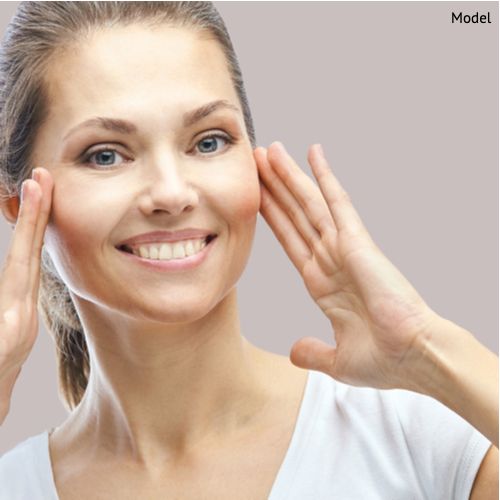What Is the Best Alternative to a Facelift?
Posted September 23, 2019 in Facelift
Adults deal with the stress of facial aging every day. Starting in your 30s or 40s, most people will begin to notice the gradual loosening of the skin, diminishing volume, and other subtle changes in facial appearance.
These changes will not happen overnight, and you will not go from having youthful, taut skin one day to deciding you need a facelift the next. However, given enough time, facial aging will find you eventually.

Natural beauty portrait with hands touching face.
Facelift surgery targets skin laxity, some deeper tissue changes and volume loss by the manipulation of these tissues of the lower two-thirds of the face.
This is the best way to address severe tissue laxity; however, not every patient falls into the category of moderate to severe facial aging.
For patients who do not need as much correction or are uneasy about the idea of undergoing invasive surgery, alternative cosmetic treatments are available that provide facial rejuvenation.
While these minimally invasive or non-surgical procedures cannot completely match the improvement of a facelift, they can address specific concerns and reduce or postpone the need for facelift surgery.
For Volume Loss
Facial volume loss occurs when the tissues in the mid-region of the face begin to break down, and adequate collagen is no longer produced.
The fat that once contributed to the youthful roundness of your cheeks and the fullness of the space between the nose and mouth starts to droop or disappear with age. This volume cannot be replenished without cosmetic help.
Even facelift surgery cannot match the boost of collagen that minimally invasive or non-surgical treatments can.
Facial fat grafting and dermal fillers are both injectable treatments that return fullness to regions of the face that have experienced loss.
While these procedures achieve similar results, they are very different techniques. Unlike fillers that are injected beneath the skin’s surface, fat grafting uses liposuction to remove fat from your body and inject it into hollowed regions of the face.
Fat grafting allows for longer-lasting fullness, as the fat is not as readily absorbed as facial fillers. There is also a much smaller chance of an allergic reaction (since the fat is harvested from your body). This procedure also allows you to slim another region of the body.
Hyaluronic acid dermal fillers like Restylane® or JUVÉDERM® can temporarily restore facial volume while stimulating collagen production. These injectables provide noticeable results for up to one year and can be repeated as necessary.
For Skin Laxity
Mild to moderate fine lines, wrinkles, and skin laxity can be treated with several non- or minimally invasive techniques.
Fat grafting and dermal fillers are useful in smoothing skin; however, laser resurfacing and microneedling are also helpful.
Fractional CO2 lasers reduce the appearance of laugh and frown lines by removing the damaged layers of skin, while microneedling makes hundreds of “micro” wounds that stimulate the production of collagen, which reduces the severity of wrinkles and creases.
For Texture Concerns
Facelift surgery cannot address skin tone and texture irregularities. Non-surgical procedures like laser resurfacing, IPL PhotoFacial, microneedling, and chemical peels address uneven skin tone and texture by reducing hyperpigmentation, acne scars, and skin redness.
These procedures can be performed alone, alongside dermal fillers or fat grafting, or even as a follow-up to facelift surgery to create a glowing complexion.
For more information on these treatments, or to find these procedures in Newport Beach, contact Dr. Ackerman by calling (949) 759-3284 or by filling out our online contact form.

